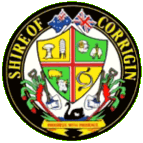Shire of Corrigin
| Shire of Corrigin Western Australia | |||||||||||||
|---|---|---|---|---|---|---|---|---|---|---|---|---|---|
 Location in Western Australia | |||||||||||||
| Population | 1,099 (2013 est)[1] | ||||||||||||
| • Density | 0.35509/km2 (0.9197/sq mi) | ||||||||||||
| Established | 1913 | ||||||||||||
| Area | 3,095 km2 (1,195.0 sq mi) | ||||||||||||
| Mayor | Lynette Baker | ||||||||||||
| Council seat | Corrigin | ||||||||||||
| Region | Wheatbelt | ||||||||||||
| State electorate(s) | Electoral district of Wagin | ||||||||||||
| Federal Division(s) | O'Connor | ||||||||||||
 | |||||||||||||
| Website | Shire of Corrigin | ||||||||||||
| |||||||||||||
The Shire of Corrigin is a local government area in the Wheatbelt region of Western Australia, about 230 kilometres (143 mi) east of the state capital, Perth. Its seat of government is the town of Corrigin. The shire covers an area of 3,095 square kilometres (1,195 sq mi) and the economy, worth approximately $50 million per year to the state economy, is based on agriculture - predominantly cereal grains and sheep,[2] with some supporting industries including a flour mill.
History
From 1891 until 1913, different parts of the area was managed by Morambine (Pingelly), Greenhills and Brookton Road Boards. In 1913, after the announcement of a proposed railway from Brookton on the Great Southern Railway to terminate in the town of Kunjin, the Kunjinn Road District was gazetted. The first Road Board members held their meetings in a small timber and iron building with their first ever purchase being a billy, tea and sugar. After only three meetings, it was decided to shift the meeting venue to the new townsite of Corrigin as Kunjin was no longer under consideration as the major rail junction. Accordingly, in 1914, the district was renamed Corrigin. On 1 July 1961, it became a Shire under the Local Government Act 1960.[3]
Wards
The first ward system, established in 1914, divided the road district into the Wogerlin, Kurren-Kutten, Bullaring, Central, Dondakin and Kunjinn Wards.[4] The first two of these were abolished in 1988 and replaced with the Bilbarin Ward, and the Central Ward gradually increased in importance, reaching a peak of 5 of the 11 councillors then in place between 1992 and 1999.[3]
From 1 May 1999 until 19 October 2007, the Shire was divided into three wards, each electing three councillors:[5]
- North Ward
- Central Ward
- South Ward
As of 20 October 2007, the council is undivided and all nine councillors represent the entire Shire.[6]
Towns and localities
Population
| Year | Population |
|---|---|
| 1921 | 1,286 |
| 1933 | 1,845 |
| 1947 | 1,445 |
| 1954 | 1,894 |
| 1961 | 2,123 |
| 1966 | 2,099 |
| 1971 | 1,766 |
| 1976 | 1,736 |
| 1981 | 1,620 |
| 1986 | 1,450 |
| 1991 | 1,384 |
| 1996 | 1,276 |
| 2001 | 1,227 |
| 2006 | 1,145 |
Notable councillors
- Brendon Grylls, Shire of Corrigin councillor 2000–2001; later a state MP
References
- ↑ "3218.0 Regional Population Growth, Australia. Table 5. Estimated Resident Population, Local Government Areas, Western Australia". 3 April 2014. Retrieved 11 September 2014.
- ↑ Agriculture WA (July 2000). "Agriculture Statistical Overview 96/97 - Shire of Corrigin" (PDF). Archived from the original (PDF) on 2006-09-17. Retrieved 2006-11-15.
- 1 2 WA Electoral Commission, Municipality Boundary Amendments Register (release 3.0), 31 July 2007.
- ↑ Shire of Corrigin (17 July 2008). "Our Council". Retrieved 11 December 2009.
- ↑ "Local Government Act 1995 - District of Corrigin (Ward Boundaries and Representation) Order 1999". Western Australia Government Gazette. 29 January 1999. p. 1999:281.
- ↑ "Local Government Act 1995 - District of Corrigin (Discontinuation of Ward System) Order 2006". Western Australia Government Gazette. 17 November 2006. p. 2006:4774.
External links
Coordinates: 32°19′37″S 117°52′30″E / 32.327°S 117.875°E